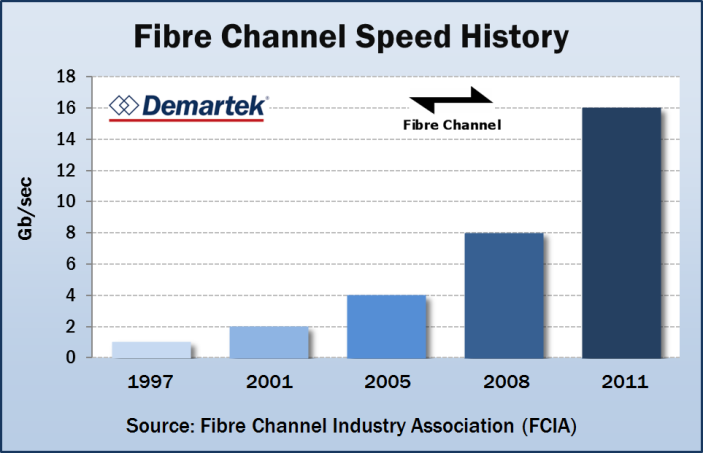Demartek Comments on 16 Gb Fibre Channel (16GFC) and Backward Compatibility
April 2013
By Dennis Martin, Demartek President
We have been testing 16 Gb Fibre Channel (16GFC) in our lab for more than a year, and were curious about backward compatibility.
16GFC with 8GFC and 4GFC
The official statement from the Fibre Channel Industry Association (FCIA) and the various vendors of these products is that Fibre Channel is backward compatible with the two previous generations. This means that 16GFC switches, host bus adapters (HBAs) and optics (transceivers) are backward compatible with 8GFC and 4GFC. We have conducted various test projects with 16GFC switches connected to servers with 16GFC HBAs, 8GFC HBAs and 4GFC HBAs. We have also connected storage systems into these Fibre Channel fabrics that have 8GFC host ports and 4GFC host ports. These servers with their Fibre Channel HBAs connected into the fabric and negotiated their best speed with the switch. The same was true of the storage systems. Our servers were able to see their storage seamlessly.
16GFC and Loop Mode
16GFC does not support loop mode at full speed. If you need to use loop mode, then the best speed you will get is 8GFC, and you will have to set the components to operate at 8 Gb/sec.
16GFC with 2GFC
We wondered about backward compatibility with older 2GFC technology, so we ran some tests and spoke with some of the vendors of these products. We have servers in our lab that are fairly new and are PCIe 3.0 compliant. We have servers that are compliant with PCIe 2.0 and other servers that are PCIe 1.0 compliant. We also have some older servers that are PCI-X compliant. We put a 2GFC HBA into one of these older servers, installed the appropriate drivers, and connected it into our 16GFC fabric.
The key to backward compatibility between 16GFC switches and 2GFC HBAs is in the optics, or transceivers. When we connected the 2GFC HBA to the 16GFC switch using the 16G optics in the switch, the HBA was unable to negotiate a connection with the switch. So we took an 8G transceiver from one of our 8GFC switches (same brand of switch) and put it into our 16GFC switch. We connected the server with the 2GFC HBA into the switch port with the 8G optics, and the 2GFC HBA and the 16GFC switch port (with 8G optics) negotiated a connection, and the server was able to see the storage system and the appropriate LUNs. We did not run a full suite of compatibility tests, but simply wanted to see if the basic connection would work. See the configuration diagram below for more details.
Warning: Although we successfully connected our 2GFC HBA into our 16GFC fabric, this does not necessarily mean that all product vendors will support 2GFC with 16GFC equipment. Many of the vendors may not have tested their older 2GFC products in 16GFC environments. Customers would be advised to proceed cautiously and consult with their equipment vendors for actual compatibility and supportability with respect to using 2GFC with 16GFC.
We don’t have any 1GFC HBAs, so we couldn’t test this combination.
The table below shows the compatibility matrix compiled from our test experience or from information available from the vendors. In all cases where there is compatibility, the HBA port and the switch port usually negotiate to the speed of the slower component.
Bottom line: for Fibre Channel, the optics work with the previous two generations only.
 |
16G Switch port with 16G optics | 16G Switch port with 8G optics |
|---|---|---|
| 16GFC HBA | ✓ | ✓ |
| 8GFC HBA | ✓ | ✓ |
| 4GFC HBA | ✓ | ✓ |
| 2GFC HBA | ✗ | ✓ |
| 1GFC HBA | ✗ | ✗ |
Legend: ✓ Compatible ✗ Not compatible
Demartek 16GFC Backward Compatibility Test Configuration

Fibre Channel History and Roadmap
Part of the success of Fibre Channel as a Storage Area Network (SAN) interface has been the well-published planning of reasonably affordable and backward compatible speed steps every 3-4 years. This cadence matches well with datacenter capital equipment refresh cycles and keeps Fibre Channel at the leading edge of high performance storage. The backward compatibility with the two previous generations makes it possible to phase upgrades in as you acquire the components, rather than having to invest in an entirely new infrastructure all at once. The next speed generation will be 32GFC; it will also be backward compatible with at least the two previous generations, and will be a reasonably affordable serial-lane technology.

The FCIA and T11 technical group established a roadmap committee many years ago, and they make this roadmap available to the public. You will find it on the FCIA Roadmap page on the FCIA website.
Demartek has compiled additional information on Fibre Channel and other storage interfaces, along with encoding schemes, cabling and connector information. This storage interface comparison is available on the Demartek Storage Interface Comparison page on the Demartek website.
The original version of this page is available at /Demartek_16GFC_Backward_Compatibility_2013-04.html on the Demartek website.


 We are pleased to announce that Principled Technologies has acquired Demartek.
We are pleased to announce that Principled Technologies has acquired Demartek.